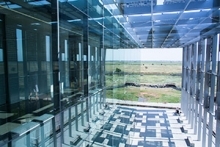 An increased gift from longtime campus partner Wells Fargo is allowing more engineering students at the University of California, Merced, to focus on solutions to problems related to water, energy and food.
An increased gift from longtime campus partner Wells Fargo is allowing more engineering students at the University of California, Merced, to focus on solutions to problems related to water, energy and food.
Wells Fargo awarded its Clean Technology and Innovation Grant to the UC Merced School of Engineering’s senior Innovation Design Clinic (IDC). The $125,000 gift — $25,000 more than last year — supports IDC’s efforts to develop, design and create engineering solutions addressing the critical water, energy, food (WEF) nexus.
In total, Wells Fargo has awarded the School of Engineering $300,000 over the past three years through the grant program.
“Wells Fargo recognizes that the health of our environment is critical to fostering more sustainable communities,” said Sandy Raco, Central Valley Area president for Wells Fargo. “Year over year, we have seen the dedication and the great strides taken by these engineering students, local companies and members of our community in finding real solutions to environmental issues affecting the Central Valley, and we want to continue to foster that growth and momentum.”
“Wells Fargo’s gifts are very much appreciated,” School of Engineering Dean Mark Matsumoto said. “The company’s support of the Innovate to Grow program and the capstone designs significantly enhances the culminating design experience of our UC Merced engineering students and provides us with an opportunity to showcase their creative and innovative talents to the engineering professional community and the community at large.”
The students on 24 IDC teams will showcase their work at the annual Innovate to Grow competition, where industry representatives and the public will see presentations, designs and prototypes of solutions to problems faced by companies like Blue Diamond, Pitman Family Farms, E&J Gallo, Pacific Gas and Electric Company and many others. Seventeen teams fall within the WEF scope.
“Wells Fargo is making these projects possible, in many cases, because not all of the partners can viably financially support the work,” said Professor Ashlie Martini, who oversees the capstone program and Innovate to Grow. “The funds allow the students to attend client meetings, build prototypes and build functional, working solutions in some cases.”
IDC allows students to apply their classroom knowledge to real problems, and they get the kind of experience potential employers are looking for.
“All of our academic careers we are told by professors that in the ‘real world,’ we are expected to work in interdisciplinary teams with different types of individuals,” Peach Perfect team leader Gustavo Cruz said. He and his teammates are working on a new method for peeling peaches for a large fruit-processing company. “Here is an outstanding opportunity to experience what it truly means to be a part of an interdisciplinary team.”
Besides peach peeling, projects this year include a more efficient way to use biomass for energy; a robotic bedding cleaner for poultry farms; more efficient almond blanching; wine-bottling optimization; more efficient application of salt for cheese making; and a more efficient tomato harvester, among many others.
Innovate to Grow highlights the work of the IDC and Engineering Service Learning teams. Another component of the event is the Mobile App Challenge, in which teams develop applications related to health care, civic engagement, the environment, energy and education.
Teams are judged by industry representatives on the merits of the designs and the research that supports them, innovation and presentation.
The event takes place all day Friday, May 13, on campus and is free and open to everyone. Organizers ask that people register online so they can make sure there is room for everyone. Details are available on the Innovate to Grow website.



